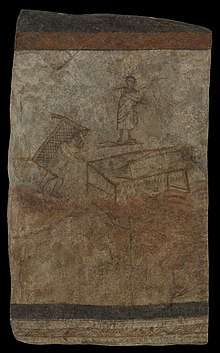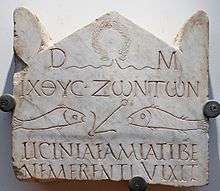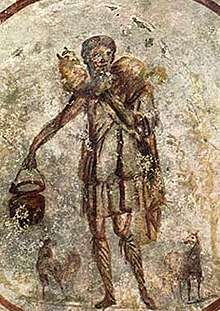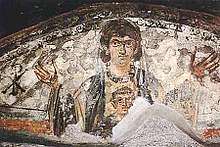



.png)
Early Christianity is the period of Christianity preceding the First Council of Nicaea in 325.
Quotes
- In considering the spiritual significance of icons and other kinds of religious art, it is helpful to observe that theological reflection on art has often lagged behind practice. Early Christian murals, mosaics, catacombs and sarcophagi receive little theological comment in their time. Yet, especially after the fourth century such art was more extensive than anything one might expect on the basis of certain attacks on images by Church Fathers - attacks that we now realize ere intermittent in any case.
- “New SCM Dictionary of Christian Spirituality edited by Philip Sheldrake” SCM Press, (2005); Art and Spirituality, Frank Burch Brown, p. 127.
- The beginnings of an identifiable Christian art can be traced to the end of the second century and the beginning of the third century. Considering the Old Testament prohibitions against graven images, it is important to consider why Christian art developed in the first place. The use of images will be a continuing issue in the history of Christianity. The best explanation for the emergence of Christian art in the early church is due to the important role images played in Greco-Roman culture.
As Christianity gained converts, these new Christians had been brought up on the value of images in their previous cultural experience and they wanted to continue this in their Christian experience. For example, there was a change in burial practices in the Roman world away from cremation to inhumation. Outside the city walls of Rome, adjacent to major roads, catacombs were dug into the ground to bury the dead. Families would have chambers or cubicula dug to bury their members. Wealthy Romans would also have sarcophagi or marble tombs carved for their burial. The Christian converts wanted the same things. Christian catacombs were dug frequently adjacent to non-Christian ones, and sarcophagi with Christian imagery were apparently popular with the richer Christians.- Allen Farber, “Early Christian Art”, Khan Academy, Smart History, (August 8, 2015)
- The public veneration of saints in the Christian Church is known to have existed in the 2nd century. As will be shown below, it developed in local communities; it was based on the saint's tomb; it was a consequence of the general belief that a martyr who shed his blood for Christ was certainly in Heaven and able to exercise intercessory prayer on behalf of those who invoked him. It has often been asserted that the cult of saints was both a borrowing from and a substitute for the polytheistic cults of the ancient Graeco-Roman world. In its crude form the theory is completely unconvincing, especially when the nature of the cults is considered and placed in its context of Christian doctrine, worship, and life. But it can readily be conceded that many eternal elements such as anniversaries, shrines, incubation, and iconography have all been at the very least deeply influenced by pagan Mediterranean models. Nevertheless, the cults of saints originated in the beliefs and practice of Jewry and early Christianity.
- David Farmer, “Oxford Dictionary of Saints”, Oxford University Press Inc., New York (1978), p. ix
- Inquiry shall likewise be made about the professions and trades of those who are brought to be admitted to the faith. ... If a man is an actor or pantomimist, he must be rejected. ... A gladiator or a trainer of gladiators, or a huntsman, or anyone connected with these shows ... must desist or be rejected. ... A soldier of the civil authority must be taught not to kill men and to refuse to do so if he is commanded, and to refuse to take an oath; if he is unwilling to comply, he must be rejected. ... If a catechumen or a believer seeks to become a soldier, they must be rejected, for they have despised God.
- Hippolytus of Rome, Apostolic Tradition, in Readings in World Christian History (2013), pp. 17-22
The early Christians rejoiced at being deemed worthy to suffer for what they believed. In those days the church was not merely a thermometer that recorded the ideas and principles of popular opinion; it was a thermostat that transformed the mores of society. Whenever the early Christians entered a town, the people in power became disturbed and immediately sought to convict the Christians for being "disturbers of the peace" and "outside agitators"' But the Christians pressed on, in the conviction that they were "a colony of heaven," called to obey God rather than man. Small in number, they were big in commitment. They were too God intoxicated to be "astronomically intimidated." By their effort and example they brought an end to such ancient evils as infanticide, and gladiatorial contests.
Things are different now. So often the contemporary church is a weak, ineffectual voice with an uncertain sound. So often it is an arch supporter of the status quo. Far from being disturbed by the presence of the church, the power structure of the average community is consoled by the church's silent and often even vocal sanction of things as they are.
- Leaving his beloved teacher Origen behind in Caesarea Maritimma about the year 240, bound for his distant home in the province of Pontus, Gregory of Neocaesarea (Niskar) turned to a catastrophic flight of rhetoric:
I may be going to prosecute no safe journey, as it sometimes fares with one who quits some safe and peaceful city; and it is indeed but too likely that, in journeying, I may fall into the hands of robbers, and be taken prisoner, and be stripped and wounded with many strokes, and be cast forth to lie half-dead somewhere.
Many miles of road lay ahead of him. Edward Gibbon would say of the Roman roads of the Antonine age that they 'united the subjects of the most distant provinces by an easy and familiar intercourse'; but however 'easy and familiar' these roads supposedly were, cities were much safer.
For the modern historians of the early churches cities have had a similar appeal. Christianity, Thomas A. Robinson notes, 'was, supposedly an urban religion'. Noting how widespread this view is ('almost every recent scholar of the early church' had held it), Robinson cites powerful names - Ramsay MacMullen and W.H.C. Frend - before naming Wayne A. Meeks (in The First Urban Christians) as the historian 'primarily responsible for the now near-universal assumptions of the urban character of early Christianity'.- Paul McKechnie, “Christianizing Asia Minor Conversion, Communities, and Social Change in the Pre-Constantinian Era”, Cambridge University Press, (2019), p. 1
- Robinson has snatched away the comfort of the urban thesis. The idea that at the time of the Edict of Milan (313) some 10 per cent of the population of the Roman empire was Christian, 6 million persons out of a population of 60 million, has been (he observes) commonly put forward as a working assumption for the size of the Christian movement. But the Roman empire was largely rural with as few as 10 per cent of the population living in cities. If the rural Christian population approximated to zero, the cities would then have to be thought to be (at least) largely Christian - which ample evidence shows that they were not. Therefore, the numbers usually cited in recent work for the size of the Christian population cannot stand; and neither can the claim of no substantial number of Christians in rural areas. The model normally drawn on in studying the growth of early Christianity, therefore, is no longer plausible. Like Gregory, the historian must leave the 'safe and peaceful city' behind.
- Paul McKechnie, “Christianizing Asia Minor Conversion, Communities, and Social Change in the Pre-Constantinian Era”, Cambridge University Press, (2019), p. 2.
- Early Christianity was primarily an urban movement. The original meaning of the word pagan (paganus) was "rural person," or more colloquially "country hick." It came to have religious meaning because after Christianity had triumphed in the cities, most of the rural people remained unconverted.
- Rodney Stark, “Cities of God: The Real Story of How Christianity Became an Urban Movement and Conquered Rome”, HarperCollins, (Oct 31, 2006), p. 2
- [I]n the words of Friedrich Engels, "Christianity was originally a movement of oppressed peoples: it first appeared as the religion of slaves and emancipated slaves, of poor people deprived of all rights, of peoples subjugated or dispersed by Rome" After all, the Bible often directly addresses the poor and downhearted and promises that they will be compensated in heaven, where the "first shall be last, and the last, first." Despite this 'evidence', a consensus has formed among historians of the early church that regardless of biblical assurances to the lower classes, the early Christians were drawn mainly from the ranks of the privileged. E.A. Judge identified the early Christians as recruited mainly from among "a socially pretentious section of the population of big cities." and Abraham Malherbe concluded that the language used by early Christian writers clearly reflects a literate, educated audience. In his detailed study of the church in Corinth in the first century, Gerd Theissen identified wealthy Christians, including members of the "upper classes." Many other historians of the early church have expressed similar views.
- Rodney Stark, “Cities of God: The Real Story of How Christianity Became an Urban Movement and Conquered Rome”, HarperCollins, (Oct 31, 2006), pp. 8-9
The Oxford Handbook of Early Christian Archaeology, edited by David K. Pettegrew, William R. Caraher, Thomas W. Davis; Oxford University Press, (Dec 20, 2018)

- Students and scholars of the New Testament of Late Antique religion have consequently been on their own in constructing a framework that links historical interpretation with archaeological practice. The reader has much to gain from W. H. C. Frend's historical overview of early Christian archaeology (1996), Grayson Snyder's compilation of archaeological sources before the reign of the emperor Constantine (2003), and the growing studies of specific periods (e.g., Charlesworth 2006; Horsley 1996; Magness 2011) and cities and regions (e.g., Burns and Jensen 2014; Magness 2012; Nasrallah, Bakirtzis, and Friesen 2010). The steady output of a generation of historians of art and architecture had led to foundational treatments of Christian buildings and visual culture (e.g., Jensen 2000; Krautheimmer 1965; Mathews 1999; White 1996; Yasin 2012b), as well as a comprehensive encyclopedia of Christian Art and Archaeology (Finney 2017). The development of medieval archaeology in the West, Byzantine archaeology in the Levant and Near East, and Late Antique archaeology has likewise produced a sizable corpus of publications that establish the broader social, religious, political and economic contexts of Late Antiquity and early Byzantium from material evidence (see, e.g., the Late Antique Archaeology series edited by Luke Lavan and Rutger et al. forthcoming). Regional approaches shaped by sectarian, national, colonial, and disciplinary interests have also contributed to our understanding of the early Christian world. Despite a strong academic and popular interest in the archaeology of early Christianity, there exist no comprehensive handbooks that synthesize archaeological evidence specifically related to early Christianity and survey debates in the field.
- Ch. 1, "The Archeology of Early Christianity", William R. Caraher and David K Pettegrew, p. 2
- The academic field known as early Christian archaeology had its roots in Italy in the wake of the Renaissance (Frend 1996, 11-22), although the goal of unearthing the relics of saints and Christian holy sites in an ancient and medieval tradition (se, e.g., Chabarria Arnau, Chapter 29). The first explorers of the Christian monuments of Rome in the late fifteenth century were guided by the antiquarian pursuit of the ancient world, which included classical remains as much as early Christian monuments (Schuddenboom 2017). While competing national drives to collect antiquities fueled Classical archaeology in Europe, the Protestant Reformation infused the archaeology of early Christian remains with a more burdensome, apologetic role: assessing the Catholic version of Christian history through the material culture of its early believers. In 1632, for example, the Catholic priest Antonio Bosio published his exploration of the Christian communities in Rome and to challenge Protestant attacks on the Roman church's ancient pedigree. While both polemic and curiosity guided these initial explorations, the first investigators forged a relationship between Christian material remain and the theology, history, and institutions of the early church.
- Ch. 1, "The Archeology of Early Christianity", William R. Caraher and David K Pettegrew, p. 3
- Objects, art, and architecture of an explicitly "Christian" character appear for the first time in the archaeological record in the second and third centuries. While the corpus of known artifacts from this era remains very small and has not increased appreciably in recent decades (e.g. Snyder's 2003 compendium of pre-Constantinian remains is hardly different from the original edition in 1985), Longnecker's recent study of the ubiquity and significance of the cross before Constantine (2015) highlights the potential value in reexamining older material. The paucity of material reflects real demographic factors such as the small number of Christians in this period as well as the relatively limited group of Christian elite who might produce the sort of material signature that archaeologists typically detect. But the absence of evidence may also point to the nature of representation in these early communities, their adherence to Mosaic proscriptions against iconic art, and their blending with the social worlds they inhabited (Finney 1997; Jensen 2000). Indeed, the creation of a distinctly Christian iconography (Bisconti 1999; Rutgers 2000, 82-117; Snyder 2003, 2) and purpose-built places of worship often involved very minor or subtle changes to existing forms (Bisconti, Chapter 11; Britt, Chapter 15). That Christians appear at all in the material culture of this period points to the numerical and material growth of the church, as the catacombs and burial sites in Rome and other places attest (Fiocchi Nicolai, Chapter 4). While it remains very difficult to discern religious identity in the material culture of this period, the emergence of distinctly Christian art or objects nonetheless speaks to common patterns of belief, community, and liturgy.
- Ch. 1, "The Archeology of Early Christianity", William R. Caraher and David K Pettegrew, p. 13
- Texts number among the earliest extant Christian artifacts and reveal important details about the authors and communities that produced them. Even the physical features of manuscripts themselves can reveal in their material, form, and symbols a wealth of information (Hurtado 2005). Early Christian texts, however, have frequently appeared without substantive archaeological context or provenience, and are regularly the subject of forgery. Scholars have often had to date major discoveries such as the Oxyrhynchus Logia, the well-known Nag Hammadi codices, and numerous new papyrus fragments from Egypt to the first two centuries of Christianity on the basis of evidence internal to the texts (Brooks Hedstrom, Chapter 34). A similar lack of stratigraphic context bedevils the study of inscriptions from Christian burials and catacombs. Letter forms and language date a series of Christian funerary inscriptions in Phrygia and Lycaonia in Asia Minor to the second century indicating that Christian communities felt sufficiently secure to identify with their faith publicly (Talleon, Chapter 26).
- Ch. 1, "The Archeology of Early Christianity", William R. Caraher and David K Pettegrew, pp. 13-14
- Mortuary contexts also provide some of the earliest evidence for a Christian visual culture. From the first part of the third century, Christian catacombs featured art depicting biblical scenes of resurrection, salvation, and redemption (Lazarus, Susanna, Daniel in the lions' den, the sacrifice of Isaac), alongside both Christian symbols and pagan images that could convey new meanings (Bisconti, Chapter 11; cf. Bisconti 1999, 100-30 for an overview of common themes). Scholars have likewise long recognized the link between earliest Christian sculpture and themes present in funerary contexts (Kristensen, Chapter 18; Jensen 2000). Parani (Chapter 17) discusses how the earliest lamp forms of the third century with scenes of Noah, Jonah, and the Good Shepherd paralleled funerary art in other media and evoked the Christian concept of redemption and resurrection. Perhaps these mortuary contexts account for the appearance of Christian imagery in other media, although the emergence of amulets with Christian imagery as early as the third or even second centuries seems to indicate a somewhat different purpose; harnessing the power of the Christian god in their daily affairs (Cline, Chapter 19). Despite the troubling absence of secure archaeological contexts, the evidence does point to distinct forms of Christian material culture emerging by the third century that often point to the theological reflection on Christ's victory over death.
- Ch. 1, "The Archeology of Early Christianity", William R. Caraher and David K Pettegrew, p. 14
- The scientific work of archaeologists adds a significant piece to our reconstruction and understanding of these early Christian martyria. Material culture fills in numerous gaps left by the literary record and provides a necessary corrective to analysis based wholly on the textual record. Indeed, the best work in early Christianity integrates archaeology with other forms of evidence. Archaeology thus contributes a critical piece to a holistic view of the early Christian cult of the martyrs and the means by which Christians created sacred spaces for venerating these martyrs.
- Ch. 5, “Martyria of the Fourth Century”, David L Eastman, p. 101
- The contextual studies of human skeletal remains in the eastern Mediterranean offer a significant avenue for understanding early Christians and their burial practices. Early Christian cemeteries found in association with churches and basilicas demonstrates definite change in burial practice from the preceding era. The body was positioned in a regular manner in this period burials were single or multiple, and the practice of secondary burial was observed. Unusual funerary deposits point to war, epidemic disease such as plague, or changing cultural practices associated with the treatment of deceased newborn or stillborn infants. While demographic data shows some local variation, there are also many similarities in Christian populations such as the relative ages at death of males and females (28.5 years and 30.7 years, respectively), disease patterns, and chronic health conditions.
- Ch. 6, “Human Remains of the Eastern Mediterranean in Early Christian Context”, Sherry C. Fox and Paraskevi Tritsaroli, p. 121
- If late Roman amulets are to be believed, than the dangers talking early Christians and their neighbors were manifold and omnipresent. The texts and images on amulets offer protection from disease, pain, aggressive magic, physical attack, and demonic onslaught, as well as other threats to body and soul. Such apotropaic objects were particularly employed when the dangers were beyond the control of individuals, states, or institutions, and when the precise threat was as yet unknown. The texts, forms, and images employed on amulets give shape on the thoughts and concerns that occupied the waking hours and anxious nights of early Christians - subjects that rarely appear in more public artistic media.
Importantly for the study of early Christianity, protective amulets display what are thought to be some of the earliest appearances of distinctively Christian symbols, some dated as early as the late second to third century, where they appear alongside Greek, Roman, Egyptian, and Jewish names and symbols. The appearance of Christian symbols among other ritually potent, religiously diverse symbols suggests the gradual emergence of a popular perception that the Christian God and associated celestial beings, saints, names, and symbols were effective when deployed for defense against maleficent forces.- Ch. 19, “Amulets and Ritual Efficacy of Christian Symbols”, Ranghar H. Cline, p. 351
See also
- Constantinian shift
- First century Christianity
- Category:Church Fathers